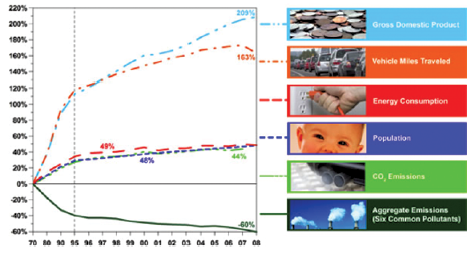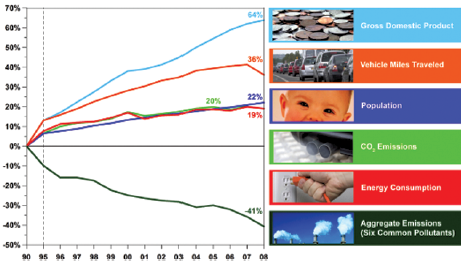by Ed Morrissey
Last week, the EPA released its annual report on air quality trends … and no one noticed. Why? Unlike most environmental reports, this one didn’t contain dire warnings about the threat of disaster. In fact, as the Institute for Energy Research notes, the EPA discovered that our air has gotten progressively cleaner over the last four decades, and significantly so over the last 20 years:
On Wednesday, the Environmental Protection Agency (EPA) quietly released its annual report on air quality trends. You would never know it from picking up a newspaper or reading news websites, but the report contains great news. Air quality in the United States has dramatically improved and, according to all indicators, it will continue to improve.
Since 1990, the EPA reports, nationwide air quality has improved significantly for the six common air pollutants. These six pollutants are ground-level ozone, particle pollution (PM2.5 and PM10), lead, nitrogen dioxide(NO2), carbonmonoxide(CO),andsulfur dioxide(SO2). Nationally, air pollution was lower in 2008 than in 1990 for:
• 8-hour ozone, by 14 percent
• annual PM2.5 (since 2000), by 19 percent
• PM10 , by 31 percent
• Lead, by 78 percent
• NO2 , by 35 percent
• 8-hour CO, by 68 percent
• annual SO2 , by 59 percent…
This is good news that air quality continues to improve and even more so because the American people do not know it. According to a 2004 poll from the Foundation for Clean Air Progress, only 29 percent of people thought that “America’s air quality is better than . . . it was in 1970.”
This graphic from the EPA shows the trend since 1970: Since 1990:
A few points to note here. First, I grew up in Southern California,
when smog alerts were commonplace and it sometimes got so bad that it hurt to breathe. That would have been at the front end of the 40-year trend graph, and emissions have dropped over 60% during that time. However, a big part of that came over the last 20 years, as the second graph shows. Both graphs show remarkable economic growth unrelated to emissions-restriction efforts and, for that matter, population growth. Most intriguingly, travel has gone up much faster than population growth while emissions declined.
The carbon emissions data is also instructive. In both graphs, its linkage to population growth is so close that the actual percentage has to be moved off of the right border of the graph. It also parallels energy consumption, which has grown at a slightly lower rate than population, especially over the last couple of years of the report (which may have more to do with the recession). Either way, carbon emissions are not out of control—and attempts to lower them will require an effort much different than the attempt to eliminate pollutant emissions.
Why hasn’t any news outlet reported these results? Maybe they don’t like good news, especially on the environment.


